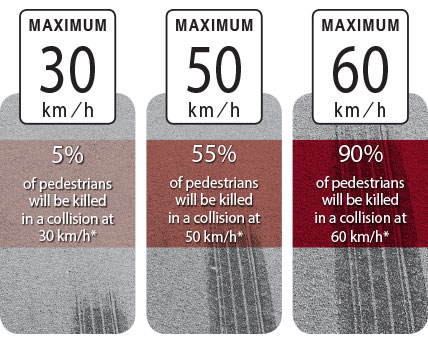Even though speed may not be the root cause of a collision, the speed at which a collision occurs is almost always the most important factor in determining whether persons involved are injured or killed.

Speed matters
The speed at which you are travelling usually determines whether or not there is time to avoid a crash. The human body has a limited tolerance to violent forces. If a crash occurs, your chance of injury increases with speed.
In Alberta, about six to seven per cent of collisions each year are attributed to unsafe speed. This number jumps to 27 per cent when looking at fatal collision statistics. (Source: Alberta Transportation, September 2013).
Speed limits
What are the Provincial legislated speeds?
Unless otherwise posted, provincial legislated speeds are:
- Provincial highways: 100 km/h
- Municipal highways: 80 km/h
- Highways in urban areas: 50 km/h
Speeds limits are legislated under the Traffic Safety Act, Section 106 and the Use of Highway and Rules of the Road Regulation, Sections 2 and 3.
Sherwood Park Freeway Speed Limits
Should you have any questions, please contact Alberta Transportation, North Central Region, at 780-674-4700. For concerns about existing or missing signs, or road maintenance, please contact Volker Stevin (maintenance contractor) at 780-877-6897.
Photo Radar
In September 2011, Strathcona County Council voted to abolish mobile photo radar enforcement and approved hiring five additional enforcement officers (Strathcona County Community Peace Officers) to not only conduct speed enforcement, but also target other driving behaviours that place motorists at risk. These enforcement officers will serve to complement the existing integrated traffic unit (RCMP & Enforcement Services) and will be visible in the community as of September 1.
Intersection control devices, including red light cameras and speed detection cameras will continue to be used at seven intersections in Sherwood Park, including three on Baseline Road and four on Wye Road.
Motorists should be aware that demerit points will be assessed on their drivers licence for moving traffic violations. Each individual issued an Alberta Driver's Licence (regular Class 5) may receive a maximum of 15 demerit points before their driving privileges are revoked. The demerits are applied to the driver's licence upon conviction of moving traffic violations. Where it relates to speeding, the following applies:
- 1 - 15 km/h over the posted speed limit - 2 demerit points
- 16 - 30 km/h over the posted speed limit - 3 demerit points
- 31 - 50 km/h over the posted speed limit - 4 demerit points
- Any speed in excess of 51 km/h over the posted limit - 6 demerit points
- Please note, it is expected to take at least eight months to process issued photo radar tickets through the court system.
Further information:
Transportation Engineering and Operations
Phone: 780-417-7100
Email: transportation@strathcona.ca
RCMP and Enforcement Services
780-467-7741


